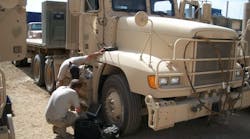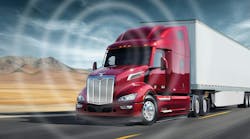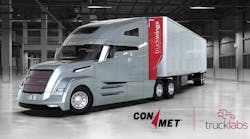It seems society is going somewhere. Today consumer products are blazing a path with high-tech products like Apple’s Siri and Amazon’s Alexa voice-command applications. Products like this use a number of technological advancements like Big Data, artificial intelligence (AI), machine learning, cloud computing and storage.
While this has long been part of the consumer world, it’s only more recently that truck OEMs and commercial fleets seem to have started adopting similar technologies for everyday operations.
As the industry shifts toward this adoption of more consistently and thoroughly utilizing data to make decisions, it will be challenging to keep up with the amount of information. But change will be pervasive.
So how can a fleet separate the claims from reality, especially when technology is changing every day?
The truth about data
In its simplest form, data is just values in some format representing transactions, readings and observations. Sensors on the vehicle record these readings and observations, which can be used to calculate different metrics. For instance, a fuel consumption sensor can provide metrics such as gallons per hour, or gallons per mile.
Other examples of data include the GPS location at a particular time, vehicle speed and engine temperature. Even work orders and customer load information are all considered data. We are now collecting data from a variety of different sources.
While terms like “Big Data” have been used the last few years, the information is nothing new. It is the access to this data, and how it’s used, that has been evolving.
When it comes to fleet operations, real-time data – coming from systems like the CMMS, on-board sensors, dispatch and order entry, and GPS data – can help to improve the decision-making process. The operational advantage can be significant, and in some instances also provide benefits to the maintenance process.
A few examples of how real-time data can improve vehicle maintenance include:
- Ability to schedule PMs when they will impact the delivery cycle the least. This help to improve demand hours.
- Shop scheduling will be more complete and reliable with fewer disruptions
- Catastrophic events will fall dramatically because some of those events broadcast themselves from the sensors as soon as there is a concern (like oil or coolant issues).
- Rebuilds will be better scheduled and only the worn parts will be replaced.
The list can go on, but the idea that better information in the hands of the people who can use it supports intelligent decision-making.
Data for decision-making
One of the main challenges of utilizing data for better decision-making is access to and efficient analysis of this information.
In an ideal world, all the data generated by the truck is collected and sent to the cloud for storage. A cloud-based software program performs the analytics and provides suggestions for what to do and how soon to do it.
But in the real world, there is information in myriad different places or programs, including everything from the line setting ticket, to the VMRS codes for all prior repairs, open work orders, etc. Not to mention factors such as seasonality, geographic location, topography and weather.
With the data available from many sources, it is critical to find a way to combine this information into new ways for a deeper look at what is going on with the vehicle.
A truck’s fuel consumption can be monitored and correlated with load weight, terrain and weather. If the situation is degrading, the truck can be flagged for service.
Readouts of engine and transmission data will detect faults before they become catastrophes. The software will continuously monitor for “not to exceed” values, and trends to alert the driver and dispatch of the issue. Decisions can be made in real-time with considerations to the vehicle load, customer, distance from service stop and location of replacement units or parts.
Software analyzes this data with pre-programmed parameters input into the program. If and when the analyzed data registers outside of these parameters, the software program notifies the fleet of an issue. The fleet can then make an educated decision about taking the unit out of service at a particular time based on this information.
The software can be programmed to monitor driver behavior. On-board systems can sense driver impairment for things like fatigue, sickness or substance use.
The transformation of data usage
The adoption and use of data can be categorized into three stages of transformation. Those stages are access to vehicle data, real-time diagnostics, and a higher level of comprehensive data analysis.
Stage 1: Access to the data
Vehicle system and component sensors provide data readouts, which are accessible by scan tool or other diagnostic tooling. Dependent on the maintenance operation, like the case of a local Kenworth dealer, software management platforms are available to assess this data in the shop, and connect to other programs. For example, Kenworth launched a cloud-based Service Relationship Managment (SRM) platform, powered through Decisiv, giving the technician access to all the possible relevant information.
The SRM platform provides detailed information on vehicle specs, parts catalogs, service bulletins, warranty and repair history, etc. This information can help the fleet diagnose, estimate and complete service work more quickly and efficiently.
Stage 2: Access to real-time diagnostic data
Kenworth has also taken the data collection technology to the next stage, with the ability to access and monitor real-time vehicle data through the TruckTech+ Remote Diagnostics platform available on the company’s heavy duty trucks.
“The technician may be able to skip those diagnostic tests and start work immediately on solutions, by relying instead on real-time diagnostic data from the truck’s engine control module,” Mark Wasilko, Vice President - Marketing Services for Decisiv, says. Wasilko advises real-time diagnostic information from a variety of systems and sources can help fleets make better decisions.
It works by the vehicle generating data, with the data then sent to the cloud for storage. In the cloud, this data is accessible by the fleet, and the dealer or OEM and can be monitored in real-time. This ability gives the fleet a jump on dealing serious deterioration or defects.
This technology is already in use at Central Oregon Trucking Co. in Redmond, Ore., contributing to on-time delivery and optimized maintenance schedules. Real-time vehicle diagnostics information is transmitted 24/7 from the fleet's maintenance facility to the local Kenworth dealer. The fleet can also view this information through the Paccar Solutions web portal in their shop to confirm how and when a specific issue will be addressed.
“It allows us to complete shipments, and schedule the servicing for when the driver returns to home base, or somewhere along the way when the driver is off-duty,” Josh Laughlin, maintenance specialist for Central Oregon Trucking Co. says.
This process of real-time data stream review and analysis can help save money and improve customer service. Adding GPS location capabilities, a fleet can determine the severity of the issue, review the location of available dealers on the truck’s route and the delivery schedule of the truck, to make an informed decision to fix it immediately, when it gets back to the shop or during scheduled future maintenance.
The decisions made by the fleet or dealer is based on data from a variety of systems and sources and is critical to the decision-making process, according to Wasilko.
Only then can the dealer make optimal business decisions for their customers. Good customer service leads to stickier customers, potentially more revenue and vehicle uptime.
Stage 3: Higher level of comprehensive data analysis
The next step to using data for maintenance involves accessing and using ‘Big Data.’ Big Data may seem like an intimidating term, but it really refers to the combination of all the available data that has been collected.
Big Data can be better described through the four “V’s:” volume, velocity, variety and veracity.
- Volume: The best driver might scan his or her oil temperature once every couple of minutes. Vehicle sensors can scan the system every second. All of this information is recorded.
- Velocity: The data sources are working much quicker than ever before.
- Variety: All the data has always been available. The difference with Big Data is that it is all together in one place. Now we can correlate weather and cranking systems or changes in altitude with brake repair, for example.
- Veracity: dealing with the uncertainty of the data by cross-checking it with other data and using advanced statistics to ferret out the truth.
The industry is in the early stages of this adoption currently, with software having the ability to provide more insights to the performance of the vehicle and decision-making process.
Real-world example
While not directly related to on-highway commercial vehicles, mining equipment maintenance has a number of similarities.
For instance, a Caterpillar mine haul truck has about 145 sensors. As each sensor reports its readings, the data files start to get quite large. Add to that other data points from outside conditions such as weather, incoming orders, traffic conditions, fuel prices along the route, etc.
Here are a few of the 145 sensors that are putting readings into the cloud every second:
- Engine Coolant Pump Outlet Pressure
- Engine Coolant Temperature
- Engine Coolant Pump Outlet Temperature
- Engine Coolant Temperature
- Engine Oil Level
- Engine Oil Pressure
- Engine Oil Temperature
- Ground Speed
- Fuel Consumption Rate
- Fuel Filter Differential Pressure
- Fuel Pressure
- Fuel Rail Pressure
- Fuel Rail Temperature
- Fuel Temperature
- Fuel/ Water Separator Level Status
Reviewing each sensor’s data individually can still provide some insights to the vehicle’s operating status. While not likely able to detect a failure, simple analysis may advise:
- To change the fuel filter (Fuel Filter Differential Pressure)
- To change the oil (Engine Oil Level, Engine Oil Pressure, Engine Oil Temperature, mileage, viscosity)
But comparing data from the different sensors can provide additional insights. More complex analysis might provide insight into:
- Vehicle fuel efficiency (Ground Speed, Fuel Consumption Rate)
- Operating parameters that optimize fuel use
- Conditions that predetermine expensive failures like premature engine or transmission failures
- Specific conditions right before a major fault
Both reviewing and acting on the simple and complex analysis can help to improve the ROI (return on investment), improve unit life and improve delivery integrity. Add to that, using both the vehicle data and environmental data can make for more comprehensive analysis, and subsequently, better decision making.
The future
In the early stages of any new technology adoption there will be a number of developments and ideas that don’t go anywhere. Overall, though, the adoption of new technology has a great impact on our lives – both personal and professional. While implementing new technologies, the change may seem easier. It’s only in retrospect we might realize we’ve underestimate the depth and pervasiveness of the change.
In the next few years the technology will start to catch up to hype. Now the use cases are all individually built and painfully executed. The next generation of data usage and analysis is on the horizon, and will provide more capabilities.






